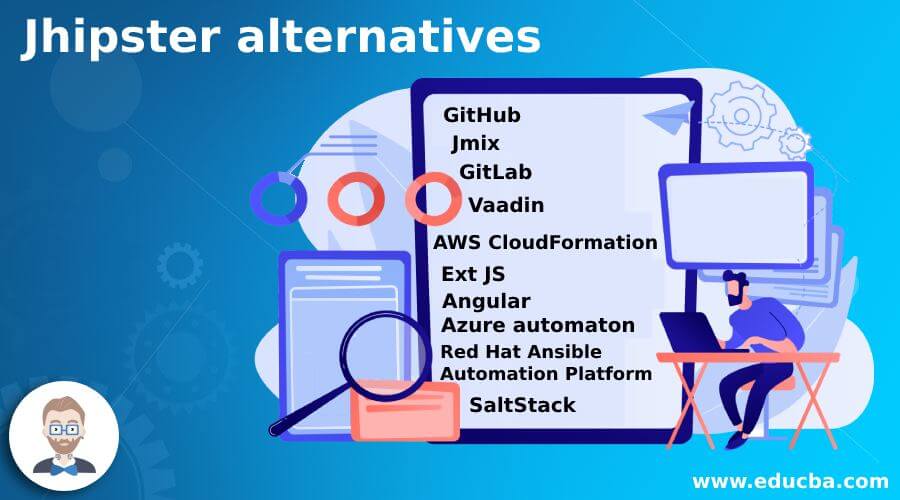Updated June 3, 2023
Introduction to Jhipster
Jhipster is a free and open-source application generator to develop modern web applications and microservices using angular or react and spring frameworks. It is written in Java. Jhipster generates full-stack applications and microservices. It also generates CRUD entities directly or by scaffolding. It provides various tools to generate a project with a Java stack on the server side and a responsive web front on the client side. Some alternatives to Jhipster provide the same functionality as Jhipster and are different in other ways. In this article, we are going to discuss these alternatives.
Alternatives of Jhipster
Given below is the list of Jhipster alternatives:
1. GitHub
GitHub is the best alternative for Jhipster. It provides internet hosting for software development and version control. It offers distributed version control and source code management functionality. It also includes other features such as bug tracking, task management, feature requests, and continuous integration. The developers write GitHub in Ruby, C, ECMAScript, and golang languages.
2. Jmix
Another Jhipster alternative is Jmix, an open-source rapid application development platform. It provides robust full-stack architecture and Rapid application development tools for easy start and fast development of modern web applications in Kotlin or Java. Its architecture uses a spring boot for handling the back and front end.
3. GitLab
Another best alternative for Jhipster is GitLab. It is a web-based DevOps tool that provides a git repository. It is used to track issues, continuous integration, and deployment pipeline. GitLab automates the entire DevOps life cycle and reduces the time of development. It provides various services such as building, security testing, deployment, monitoring, and verification. It offers high scalability and can be hosted on cloud storage or on-premises.
4. Vaadin
Vaadin is the best alternative for Jhipster. It is an open-source platform used to develop the web application. It includes web components like the Java web framework and tools and applications. Vaadin is written in Java and JavaScript language. It provides free, open-source web components to develop the application. Button, check box, radio button, combo box, date picker, context menu, drop-down menu, dialog, Form layout, ordered layout, split layout, grid, icon, UI icon set, notification, reusable list boxes, progress bar, them able input controls, navigation tabs and upload are some of these free open source components.
5. AWS CloudFormation
AWS CloudFormation allows users to create and manage the collection of Amazon web services resources by provisioning and predictably updating them. It allows users to create and model the infrastructure for the application without having to perform actions manually. It provides a template, using which users can deploy all the resources required for the application. Users can reuse these templates to replicate the infrastructure in multiple environments.
6. Ext JS
Ext Js is a pure JavaScript application framework to build the cross-web platform. Building the platform uses DHTML, Ajax, and DOM scripting. Ext Js provides a set of GUI-based controls to implement the web application. Text field, text area, date picker, radio button, check box, list box, combo box, grid control, tree control, toolbars, tab panels, menu, sidebar, and vector graphics chart are some controls provided by Ext Js. It comes in versions, one is a modern toolkit, and another is a classic toolkit.
7. Angular
Another alternative for Jhipster is angular, a free and open-source web application framework written in typescript language. Angular components are part of the module, or we can say that module contains components that implement the application’s business logic. Also, they contain the template which is going to trigger when they are invoked. Angular has improved over time in terms of performance, handling events, providing support for different browsers, and type-checking.
8. Azure Automaton
Azure Automation allows users to automate the Azure management task and orchestrate action across their external systems from within Azure. It is built on PowerShell workflow. Azure automation gives complete control during deployment, operations, and decommissioning of workloads and resources. Process automation supports integrating Azure services and other public systems required in deploying, configuring, and managing your end-to-end processes.
9. Red Hat Ansible Automation Platform
Red Hat Ansible automation platform provides an enterprise framework to build IT operation automation at scale. It uses the YAML automation language, allowing users across the organization to share and manage the automation content. Users employ it to analyze the data and, based on the analysis, generate reports on the status of automation deployments across multiple clusters.
10. SaltStack
SaltStack is a Python-based open-source framework for remote task execution, IT automation, and configuration management. Salt was designed to be highly modular and extensible, making molding to diverse enterprise IT use cases easily. SaltStack provides modules. Developers or system administrators can detach and modify these modules to suit their needs, allowing for interactions within Salt. It uses the push model for executing commands via the SSH protocol. The default configuration system is YAML and Jinja templates.
Recommended Articles
This is a guide to Jhipster alternatives. Here we discuss the introduction and the list of Jhipster alternatives in detail. You may also have a look at the following articles to learn more –


